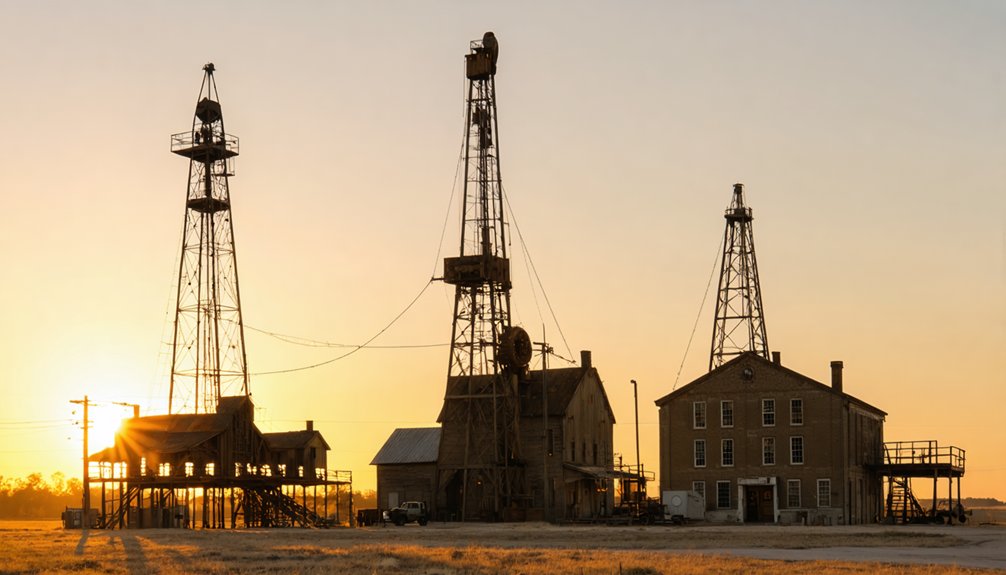You’ll find America’s best-preserved oil boom relics at the Spindletop/Gladys City Boomtown Museum in Texas, where the 1901 Lucas Gusher transformed the nation’s energy landscape. Pennsylvania’s Drake Well Museum preserves America’s first commercial oil well from 1859, featuring authentic artifacts and a reconstructed derrick. The Art Deco Connellee Hotel in Eastland County stands as an architectural symbol of Texas’s 1920s petroleum wealth. These sites offer windows into the revolutionary era that redefined America’s industrial identity.
Key Takeaways
- Spindletop/Gladys City Boomtown Museum in Texas showcases America’s first major oil gusher with reconstructed buildings from the 1901 boom.
- Drake Well Museum in Pennsylvania preserves the site of America’s first commercial oil well with 80+ displays and a replica derrick.
- The restored Connellee Hotel in Eastland, Texas stands as an eight-story Art Deco testament to 1920s oil wealth.
- Kilgore, Texas maintains authentic derricks in its downtown Oil Museum, representing the East Texas Oil Field boom.
- Pithole City in Pennsylvania features remains of an 1865 boomtown that grew to 15,000 residents before being abandoned.
The Spindletop Lucas Gusher: Birth of the Texas Oil Industry
The discovery of the Lucas Gusher on January 10, 1901, at Spindletop Hill marked a pivotal moment in American industrial history, transforming both the Texas economy and the nation’s energy landscape.
When you visit the site today, you’re standing where crude oil once blasted 100 feet skyward from a depth of 1,139 feet, producing an astounding 100,000 barrels daily.
This spectacular find launched the “Gusher Age,” making oil abundantly available nationwide and establishing Texas as an energy powerhouse. Beaumont’s population experienced a dramatic surge, growing from 10,000 to 50,000 residents due to the massive oil boom.
The well’s impressive output exceeded all other U.S. wells combined, triggering a twentyfold increase in Texas oil production. By 1929, the state was producing 35 to 45 percent of the entire nation’s petroleum supply.
Spindletop’s oil legacy lives on at the Spindletop/Gladys City Boomtown Museum, where you’ll find the pink granite monument commemorating this revolutionary moment that birthed major corporations like Texaco and Exxon.
Drake Well Museum: America’s First Commercial Oil Well in Pennsylvania
Pioneers of American petroleum history, Edwin L. Drake and his assistant Uncle Billy Smith revolutionized energy production when they drilled the first successful commercial oil well in 1859 at Titusville, Pennsylvania. This breakthrough triggered America’s oil boom, with Pennsylvania producing over half the nation’s oil between 1859-1892.
The Drake Well Museum preserves this historical significance through extensive exhibits housing the world’s most comprehensive petroleum industry artifacts and archives. The Daughters of the American Revolution played a crucial role by acquiring the site and commissioning a natural sandstone monument in 1914. Preservation efforts began with Edwin C. Bell’s initial collection (1913-1923) and culminated in the permanent museum established in 1934.
Today, you’ll find over 80 professional indoor displays alongside outdoor attractions including a board-for-board replica of Drake’s engine house and derrick on the original well site. The museum’s 240-acre grounds connect to broader natural recreational opportunities, offering both industrial heritage and environmental appreciation. Before Drake’s innovation, Native Americans, particularly the Seneca tribe, had been collecting oil from natural seeps for centuries, using it for medicinal purposes and waterproofing.
The Historic Connelly Hotel: Eastland County’s Boom Era Landmark
Standing as one of Texas’ most impressive oil boom monuments, the historic Connellee Hotel emerged in Eastland County during the prosperity-fueled 1920s.
Initiated by town founder C.U. Connellee in 1918 but completed in 1928, this architectural masterpiece bridged ambition with reality during Texas’s petroleum revolution.
The Connellee Hotel’s architectural significance stems from its imposing eight-story structure, Art Deco styling, and lavish amenities including a ballroom and roof garden.
As the grandest accommodation between Dallas-Fort Worth and El Paso, it served wealthy travelers along the Bankhead Highway.
Now restored as Eastland Civic Center, this Recorded Texas Historic Landmark preserves both physical structure and cultural heritage.
You’ll still find original architectural details that transport you to an era when oil prosperity transformed rural Texas communities into bustling economic centers. Visitors can enjoy 360-degree views from the eighth floor, offering a panoramic perspective of the surrounding landscape.
The hotel’s historical significance is further highlighted by its fifth floor’s notorious reputation, with stories of elevator operators charging for access to this area during the hotel’s heyday.
Frequently Asked Questions
How Did Oil Booms Impact Minority Communities and Their Preservation?
You’ve witnessed economic disparities as minority populations received limited employment benefits while bearing environmental burdens. Their cultural erasure continues in preservation efforts that haven’t adequately documented their experiences within oil boom towns.
What Preservation Technologies Protect Oil Relics From Environmental Degradation?
You’ll protect oil relics using specialized restoration techniques like breathable coatings, bioremediation agents, and sacrificial barriers, while implementing environmental monitoring systems to track contaminants and prevent further degradation of these historical assets.
Are There Virtual Tours Available for Inaccessible Oil Boom Sites?
Yes, you’ll find virtual exploration options through museum websites, heritage organizations, and educational platforms that offer historical documentation of remote oil boom sites through 360-degree tours and digital exhibits.
How Do Preserved Boomtowns Incorporate Renewable Energy Today?
Like phoenix rising from ashes, you’ll find preserved boomtowns transforming defunct industrial sites into renewable integration hubs—solar farms replace oil fields, wind turbines dot landscapes, and sustainable tourism initiatives showcase this energy evolution.
Which Oil Boom Relics Were Lost Before Preservation Efforts Began?
You’ve lost countless oil landmarks in Pithole and Volcano before preservation began. Wooden structures, derricks, and storage tanks in these forgotten towns succumbed to fires, dismantlement, and abandonment by 1867.
References
- https://financialpost.com/commodities/energy/drilling-for-growth-the-u-s-s-top-ten-oil-boomtowns
- https://www.youtube.com/watch?v=marfJR7i8cI
- https://badassworkgear.com/top-us-oil-towns/
- https://commons.und.edu/cgi/viewcontent.cgi?article=6232&context=theses
- https://www.americansky.co.uk/travel-inspiration/top-10-wild-west-towns-in-america
- https://en.wikipedia.org/wiki/Wikipedia:Bot_requests/Archive_74
- https://www.talonlpe.com/blog/historic-texas-oil-boomtowns
- https://en.wikipedia.org/wiki/Crude_oil
- https://en.wikipedia.org/wiki/Texas_oil_boom
- https://www.nps.gov/bith/learn/historyculture/oil-gas-industry.htm



